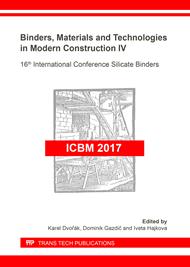p.21
p.27
p.35
p.41
p.47
p.53
p.60
p.69
p.75
Effect of the Milling Agents on Pozzolanic Activity of Glass
Abstract:
Currently the replacement of primary raw materials in cement production is relevant topic. One of the potentially usable materials can be recycled glass. But its disadvantage is tendency to agglomeration. This experiment describes the effects of the milling agents on the milling process of the glass powder. At first step seven different milling agents were compared among others and next the dependence between pozzolanic activity and specific surface are were monitored for two of them. The utilization of milling agents increased glass specific surface area significantly. Nevertheless, pozzolanic activity of the glass can be reduced when using milling agents because they may also act to a certain extent repellently to the reaction solution.
Info:
Periodical:
Pages:
47-52
Citation:
Online since:
June 2018
Authors:
Keywords:
Price:
Сopyright:
© 2018 Trans Tech Publications Ltd. All Rights Reserved
Share:
Citation:


